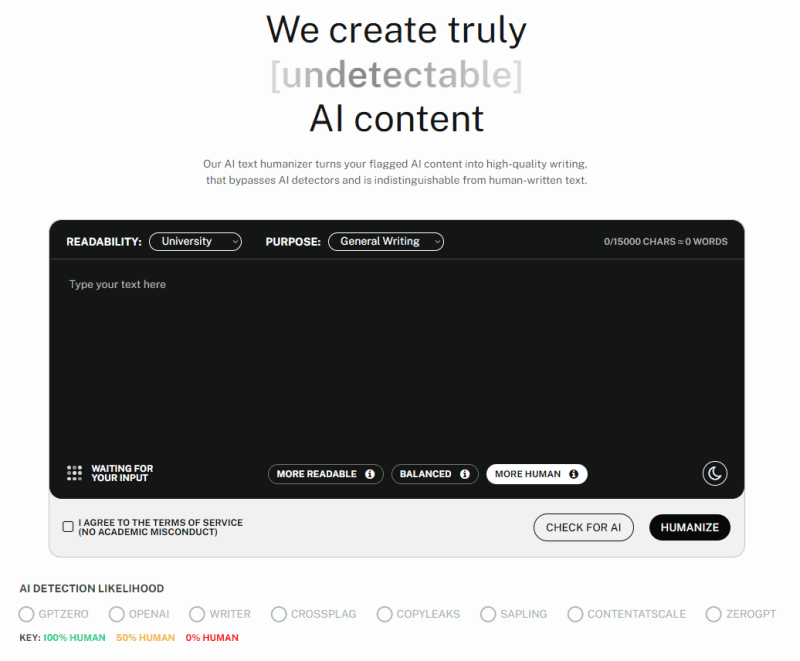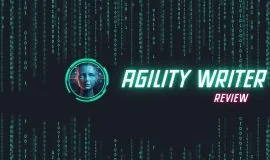Encountering issues with your AI-generated content being caught by detection tools? We understand how frustrating it is when the text you’ve taken time to perfect gets flagged as machine-written. Learning how to make AI text undetectable is easy if you use the proper tools or understand how AI works.
After extensive explorations and trialing various techniques, we have discovered a handful of effective strategies for making AI text go unnoticed – one such method is tweaking sentence syntax using Bing Chat.
Main Takeaways
- AI content detection uses smart technology to spot text written by artificial intelligence.
- Common mistakes that make AI writing detectable include predictable sentence structures, limited vocabulary, and repetitive phrases.
- To make AI-written text undetectable, we can use scrambling tools, tweak sentence syntax for a natural flow, and incorporate higher-level vocabulary.
- Different AI tools have different features and abilities to bypass AI detectors. Testing them helps understand their effectiveness.
- Making hidden AI content benefits many industries, including marketing, education, and retail. However, it also carries risks if misused.
AI Content Detection

As we delve deeper into the realm of AI content detection, it’s crucial to comprehend what it actually means. It refers to a system that spots and identifies text generated by artificial intelligence.
Understanding how this process works gives us insight into its underlying mechanics.
What is AI content detection?
AI content detection is a cutting-edge technology that uses sophisticated algorithms to find AI-generated content. It hunts for specific markers, patterns, and structures within the text that are common with AI-written pieces.
As larger language models continue to evolve, the accuracy of these detection mechanisms also increases. The main goal is to distinguish artificial intelligence-produced writing from human-created ones, ensuring authenticity and originality in digital content.
How does AI detect generated content?
Artificial intelligence technology lies at the heart of AI content detection. It leverages sophisticated algorithms to scrutinize every line of text, discerning subtle patterns that may indicate AI-generated content.
The detection process pays special attention to sentence structure, syntax, repetitive phrases, and vocabulary – common hallmarks of AI-written material. Even more impressively, advanced tools like Turnitin can flag paraphrased text from AI writing tools such as ChatGPT.
Recognizing these intricate details allows detectors to consistently distinguish human-authored content from that generated by an automated program or tool.
Common Mistakes that Make AI Writing Detectable
AI writing often becomes detectable due to patterns such as repetitive sentence structure and limited vocabulary range. These common pitfalls can easily flag content as AI-generated, undermining its credibility.
Sentence structure and syntax
Predictable sentence structure and syntax often give away AI-generated content. Adding variety and randomizing these elements is crucial to make the text undetectable. By changing how we arrange words in a sentence, we can achieve a flow that feels more natural and less like a machine wrote it.
Over-reliance on fixed phrasings or repeated structures makes content sound robotic, which aids detection tools in identifying AI-written content.
Lack of variation in vocabulary
AI tools often fall into the trap of using a limited and repetitive set of words. This lack of variation in vocabulary is a classic sign that content might be AI-generated, making it easy for top AI detectors to flag.
In many instances, this monotony can tarnish the quality of your content and make it less engaging for readers. To bypass AI detection, we must strive to use diverse vocabulary in our writing style.
Adding synonyms or finding new ways to express thoughts contributes significantly towards producing undetectable AI content. Incorporating higher-level vocabulary enriches the text and makes your content sound more human-written than produced by an AI tool.
Repetitive patterns and phrases
Repetitive patterns and phrases are telltale signs of AI-generated content. AI writing often follows a predictable pattern, using the same structure or syntax for multiple sentences.
These repetitions rob the text of its natural flow and make it sound robotic. Our experience with various AI writing tools shows that many lean on common phrases and cliches to fill up space.
Not only does this repetition detract from the quality of your content, but it also makes the text easier to detect by advanced AI detectors. These algorithms easily spot the lack of creativity in word choices, revealing that your content was not written by a human hand.
To improve the undetectability of any content generated by an AI writer, one must consciously break away from repeating certain phrases too often within paragraphs.
Techniques to Make AI Text Undetectable
We’ll explore techniques to make AI text undetectable, such as using AI writing scrambling tools. We’ll discuss the importance of tweaking sentence syntax for a natural flow and incorporating higher-level vocabulary.
The guys over at TechCurse made a comprehensive article on avoiding AI detection when writing articles or any piece of content. I strongly recommend giving this guide a read since it offers a bunch of tips on how to pass undetected and write good original content with ChatGPT.
White testing these methods, we aim to create AI content that bypasses detection while maintaining high-quality output.
Using AI writing scrambling tools
Scrambling tools can effectively conceal AI-generated text.
- These tools reorganize sentences and phrases: By shuffling words around, they change the original sentence structure without losing the initial meaning.
- They employ synonyms for enhanced diversity: This action adds an extra layer of disguise to the content by creating a rich variation in language use.
- They rewrite AI-written content to bypass detection: Using popular tools like Undetectable AI, we can transform AI-generated content into indistinguishable human-like content.
- Tools like ChatGPT, Jasper, and WriteSonic also effectively create undetectable AI content: They generate human-like text that’s hard to identify as AI-produced.
- Use perplexity and burstiness to assess complexity and variation: This simple prompt helps write a more human-like text that avoids AI detection.
Tweak sentence syntax for natural flow
We can transform the detectable structure of AI-generated content by tweaking sentence syntax to achieve a natural flow. Adjusting the order of words in a sentence and varying sentence lengths contribute significantly to creating human-like content.
Shuffling phrases, playing with verb tenses, or changing passive voices into active ones are simple yet effective techniques we apply for undetectable AI writing. The aim is to bypass AI detectors and produce engaging content that resonates with readers.
Seamless syntax adjustment is part of refining our AI’s training data, helping us create unique content while keeping your message clear and relatable.
Incorporate higher-level vocabulary
We can elevate the sophistication of AI-generated content by integrating higher-level vocabulary into our writing. Complex and infrequent words suggest a certain level of knowledge and language proficiency, characteristics typically associated with human writers rather than artificial intelligence programs.
Higher-level words often stimulate curiosity in readers as they bring richness to the text, making it more engaging and thought-provoking.
Moreover, leveraging advanced vocabulary demonstrates an understanding beyond basic terminologies. It adds depth to discussions and helps portray intricate thoughts effectively. A blend of common terms with high-end words increases the naturalness of the AI-generated text while escaping detection algorithms that compare predictability patterns in word usage.
Testing and Evaluating Undetectable AI Tools
We dive into the science behind testing and evaluating various undetectable AI tools, deciphering their effectiveness in avoiding detection systems. Exciting discoveries await you; continue reading for deeper insights!
Comparing different AI tools for undetectability
Our comparison of different AI tools for undetectability aims to highlight the distinctiveness of each tool, its features, and how effectively it can bypass AI detectors.
| AI Tool | Features | Ability to Bypass AI Detectors |
|---|---|---|
| Undetectable.ai | This tool rewrites AI content. | It claims to bypass AI detectors, making AI content seem like human-written text. |
| Phrasly.ai | It can remove AI detection in one click. | Its effectiveness in bypassing AI detectors hasn’t been fully validated yet. |
| AI Text Humanizer | Turns flagged AI content into high-quality writing. | Its capacity to elude AI detectors is based on predictive patterns, but it’s becoming more challenging to detect AI-written content. |
| ChatGPT | One of the most popular AI writing tools known for its large-language models. | Many AI detectors might recognize its content due to its common usage and recognizable patterns. |
| Agility Writer | One of the best AI writing tools on the market. | Using GPT-4 as a model, Agility becomes invisible to most AI detectors on the market. |
| Jasper | This AI writing tool uses unique sentence structure and vocabulary. | Its capacity to elude AI detectors is based on predictive patterns, but detecting AI-written content is becoming more challenging. |
| WriteSonic | Known for generating clear, concise content. | Its ability to bypass AI detectors might be limited due to the predictability of its writing style. |
It’s important to remember that the efficacy of these tools can vary depending on the selected detectors, the nature of the testing content, and the study’s timing.
Evaluating their effectiveness in bypassing detection
Diving into the heart of undetectable AI tools, we ascertain their true merit by assessing how well they bypass detection measures. We utilize leading AI detectors to gauge the performance of each tool.
The process includes inputting our AI-generated texts and observing whether these are flagged or slip through unnoticed. A high success rate in evading detection validates both their effectiveness and usability for content creators requiring stealthy technology assistance.
Although potential limitations might exist due to specific detector capabilities or content types, real-time testing helps us stay updated about the evolving landscape of AI writing evasion tactics.
Benefits and Risks
Understanding the benefits and risks of making AI content undetectable is crucial to maximizing its impact while ensuring ethical usage. Dive in for a comprehensive analysis!
Benefits of undetectable AI content for various industries
Making AI content undetectable offers tangible benefits across various industries. Here are a few ways it aids different sectors:
- Marketing and Advertising help create engaging content at scale, keeping social media feeds active and attracting potential customers.
- For News and Media companies, it assists in producing high-quality news articles or reports quickly, increasing output for viewership.
- Small Businesses get a level playing field against big corporations by cost-effectively creating quality promotional materials without a large marketing team. This bridges the resource gap historically separating them.
- In Education, teachers can produce varied teaching materials efficiently, enriching their students’ learning experiences.
- Content Creators and Bloggers can generate unique blog posts rapidly without struggling with writer’s block.
- Retailers benefit by creating product descriptions en masse for online listings offering many items. Undetectable AI expedites this process while maintaining high-quality content standards.
Risks and ethical considerations
We must consider the risks and ethical issues linked to making AI content undetectable. Malicious use of such technology can lead to significant problems, such as the contamination of knowledge bases on a massive scale, which could mislead readers or distort factual information.
The line between innovation and deception becomes blurred when we produce content that mimics human writing so closely it cannot be detected as machine-generated.
Many organizations are implementing AI detection tools in their policies to counter these potential drawbacks. For instance, universities may employ these tools to discourage students from using AI-written content for assignments.
Regardless, maintaining the reliability of these detection tools is vital—failure to do so could perpetuate bias and unfair treatment. Ethical considerations extend beyond academic honesty into areas like cybersecurity and privacy, where undetectable AI poses additional threats if exploited by cybercriminals.
FAQs
In our FAQ section, we’ll answer pressing questions about the detectability and ethics of AI-written content.
Can AI-written content be detected?
Artificial intelligence has come a long way in creating content that appears human-written, but AI detectors are still able to spot the difference. Essentially, these detectors function by assessing predictability ratings within text samples.
Since genuine human writing draws from personal experiences, education, and spontaneous creativity, it carries an inherent unpredictability that’s hard for AI to mimic perfectly.
Yet, advances in technology have given rise to tools like Undetectable.ai. This innovative platform rewrites AI-generated content in a manner designed to slip past detection algorithms unnoticed.
It works by breaking down predictable language patterns commonly found within AI-produced material. By introducing variety into sentence structure and incorporating higher-level vocabulary terms into the mix, this tool adds a degree of ‘natural’ unpredictability, thereby helping the revised content bypass tech-savvy watchdogs effectively.
How do you bypass AI content detectors?
There exist effective ways to bypass AI content detectors. First off, we have to humanize the content. Since AI often creates robotic-sounding text, adding a personal touch can make your text appear more human-like.
You might consider replacing repetitive phrases with synonyms or rephrasing sentences for variety and natural flow.
Using online tools such as undetectable.ai could be another approach. This tool has an uncanny knack for making AI-generated writing seem indistinguishably human. It cleverly converts flagged AI-written input into high-quality output, a feature that makes it an invaluable asset in getting around these detectors.
Lastly, always ensure proper evaluation of any method used. Try different tools and compare their effectiveness in avoiding detection while maintaining high-quality content.
While these techniques can provide benefits such as avoiding plagiarism detection or creating unique content at scale, they should not obscure potential risks like breaching ethical boundaries of originality and authorship.
What are the potential risks?
While making AI content undetectable offers several advantages, it also comes with considerable risks. One of the key issues is the potential spread of misinformation. If not monitored closely, AI might create content that misrepresents facts or presents unverified data as reliable information.
Another hazard lies in deceptive practices and intellectual property theft. With advanced algorithms that mimic human writing styles, opportunities for plagiarism multiply alarmingly.
Finally, data duplication poses a significant risk as well; when artificial and human-generated text becomes indistinguishable, false positives can distort our understanding of generated information, consequently affecting crucial decisions based on this data.
As we delve deeper into undetectable AI-generated content, awareness and management of these risks are paramount.
Conclusion
Despite the challenges, making AI text undetectable is achievable with the right tools and techniques. Mastering this process opens new possibilities in content creation while addressing ethical concerns.
With continuous technological evolution, we can expect more sophisticated methods for creating high-quality, human-like AI-generated content.















